
People can lie, but numbers never!
That’s why having a thorough understanding of the various key metrics is essential if you want to understand and optimize your email marketing efforts. In fact, you can only understand the right direction by analyzing various key performance indicators for email marketing.
While click rate and click-through rate are the most important KPIs for email marketing, other metrics are valuable too. So, in this article, we’ll focus on some key email marketing KPIs that you’ll need to keep your email campaign on track.
So, without further ado, let’s get right to the point. Let’s review all the important email marketing KPIs and their significance.
What are email marketing KPIs?
Key Performance Indicators, or KPIs, in email marketing are vital measures that provide email senders with a clear and precise view of their campaign.
To be more specific, email marketing KPIs provide you with a summed-up result of your whole email marketing campaign. They assess your entire email campaign from various perspectives and provide you with a final result in the form of numbers. And by quickly scanning these figures, we can easily determine whether your campaign is on the right track or not.
However, numerous email marketing KPIs are there to measure an email campaign, and understanding the value of each KPI is the first step in effectively evaluating a campaign.
Putting your faith in the wrong measure can lead to an unavoidable loss. On the other hand, understanding which KPIs are more valuable will help you orchestrate and optimize your email campaigns.
Remember, you should never rely solely on one KPI. Yes, in terms of effectiveness, one KPI may appear to be preferable to you over others, but it is impossible for one KPI to illustrate the entire scenario. As a result, before making a final decision, consider assessing at least 4-5 email marketing KPIs.
Keeping track of all these numbers from various sources can be exhausting. In these cases, we recommend using a marketing automation tool that can easily, quickly, and effectively provide you with a 360-degree view of all these metrics.
Grow with Affordable Marketing Automation Inside Your WordPress Dashboard!

Different types of KPIs for email marketing and their importance
As previously stated, there are numerous metrics to keep your email marketing campaign on track, each with its own significance. If you want to run an effective email campaign in an optimal way, you must first understand what they are for and how they can help you.
We’ve compiled a list of the top ten email marketing KPIs that everyone should track. Examine this list to determine which metrics you should use to keep your emails on track.
Open rate
While the open rate is no longer considered a critical email marketing metric as it once was, it is a basic metric that you can track to set some primary goals for your email marketing campaign and efficiently redecorate your emailing approach.
The open rate indicates how many people in your email campaign opened your emails. More specifically, it displays the percentage of email subscribers you could initially entice with your emails.
- How to calculate the open rate: To calculate the open rate, you’ll need to know how many emails you sent and how many people opened them. Divide the number of recipients who opened your email by the number of emails you delivered and multiply by 100.
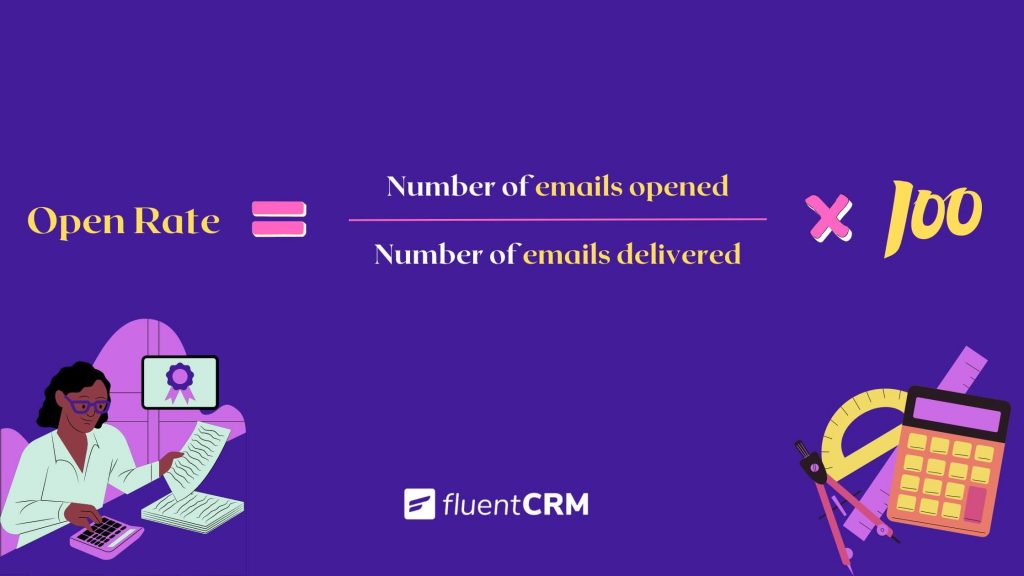
- Importance of open rate: The open rate is important because it assists you in determining the effectiveness of your email subject line and allows you to assess the validity of your email list
Click rate
One of the most important indicators that keep your email marketing campaign on track is click rate. It calculates the percentage of individuals who open an email and click on a link within it. By analyzing the click rate, you can quickly determine how well your email campaign is enticing recipients.
Remember that reaching your audience’s inboxes and persuading them to open the email with a clever subject line is not your only goal. What matters, in the end, is how many of them clicked and visited your link.
- How to calculate click rate: To calculate the click rate, you’ll need to know how many people clicked on your link and how many emails you sent. Divide the number of recipients who clicked the link by the number of emails you sent and multiply by 100. That is your campaign’s click rate.
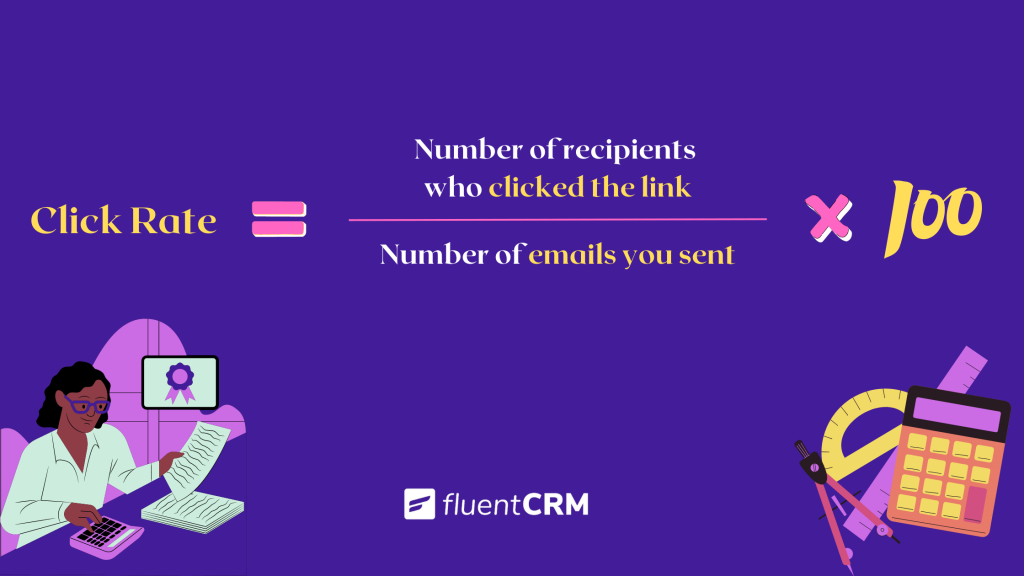
- Importance of click rate: The click rate is important because it assists you in determining the efficacy of your email marketing campaign and allows you to determine whether or not people want to receive emails from you. It demonstrates whether or not the tone of your email writing is appealing to your clients and assists you in determining the effectiveness of your email CTA.
Click-through rate (CTR)
Click-through rate (CTR) is the ratio of email recipients who opened your email and clicked on the link or CTA that you included. It is one of the most important metrics used by most digital and online marketers to assess the success and effectiveness of an email marketing campaign.
This metric frequently perplexes everyone, and many people misinterpret it by assuming there are no differences between Click Rate (CR) and Click Through Rate (CTR). Well, there are some distinctions.
The click-through rate is the percentage of people who opened your email and clicked on the link you provided (CTR). In contrast, the click rate (CR) shows the percentage of recipients who clicked.
- How to calculate click-through rate: To calculate the CTR, you must know the exact number of people who clicked the provided link and opened your email to calculate the CTR. Divide the number of recipients who clicked your link by the number of recipients who opened your email and multiply by 100 to figure out the CTR of your email marketing campaign.
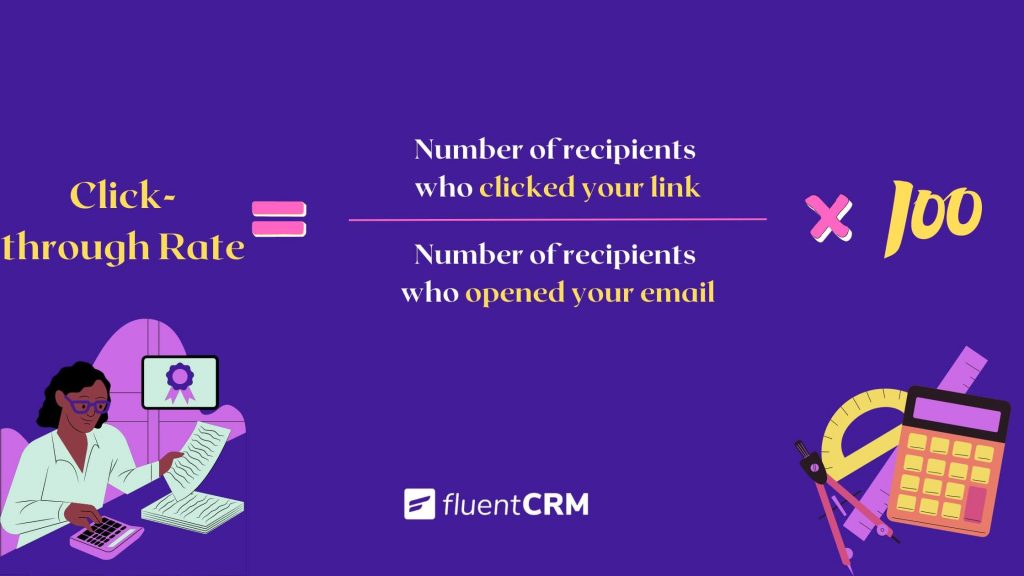
- Importance of click-through rate: The click-through rate is important because it gives you a detailed picture of how your email campaign is performing and shows whether you’re writing an email the right way or not. It tells you how many of your recipients are genuinely interested in your product or service
Conversion rate
Once a recipient has opened your email and clicked on your link, your goal is to persuade them to take a specific action. And conversion rate metrics can be used to assess how well you are doing your job.
Conversion rate indicates the percentage of email recipients who opened your email and took the desired action. To illustrate, suppose you want your recipients to fill out a subscription form after clicking on the link. The conversion rate is the metric that will show you how many of your email recipients complete this form.
- How to calculate conversion rate: You must know the precise number of people who took the specific action you desired and the total number of emails you sent to calculate the conversion rate. Divide the number of recipients who performed your desired action by the number of recipients who opened your email and multiply by 100 to figure out the conversion rate of your email marketing campaign.
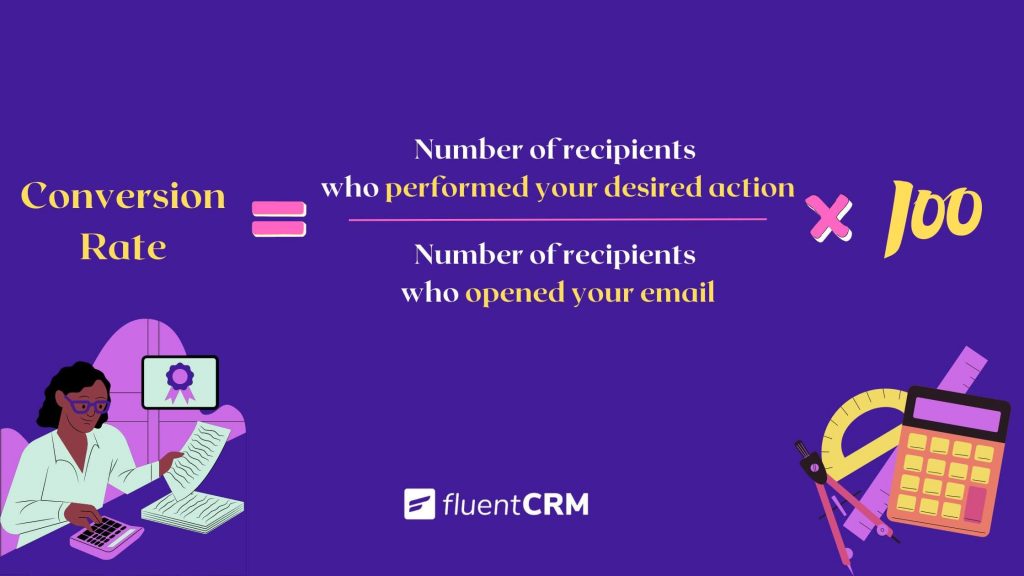
- Importance of conversion rate: The conversion rate is important because it explains the end result and demonstrates the overall success of the email marketing campaign. It also enables you to effectively decorate your lead generation journey.
Unsubscribe rate
Someone may have subscribed to your email list, but that doesn’t mean they’ll always want to be on it. Furthermore, you must include an unsubscribe link with each email to comply with various laws, such as the CAN-SPAM Act and GDPR. As a result, many recipients will unsubscribe from your email list from time to time.
If you want to run an effective email campaign, you must track the number of people who unsubscribe from your list, and the unsubscribe rate will assist you in doing so.
- How to calculate the unsubscribe rate: To calculate the unsubscribe rate, you’ll need to know how many emails were sent and how many people unsubscribed from your list. Now, divide the number of recipients who unsubscribed from your email list by the total number of emails delivered and multiply by 100.
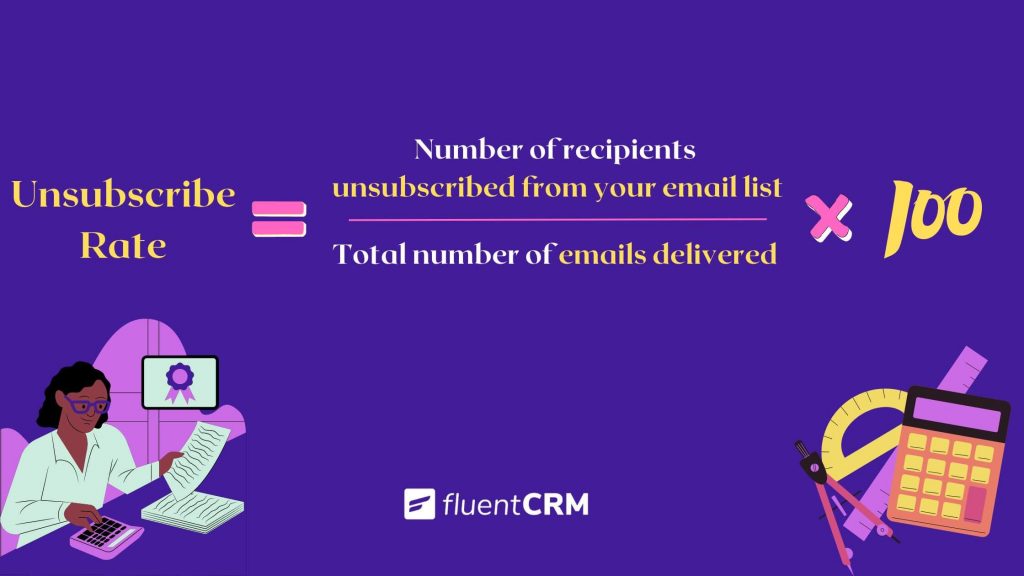
- Importance of unsubscribe rate: The unsubscribe rate is important because it allows you to assess the health of your email list and helps you determine the best and most efficient way to build your email list. It assists you in determining the best strategy for collecting email leads as quickly as possible.
Bounce rate
Knowing how many of your emails made it into your recipients’ inboxes isn’t enough to run an email campaign efficiently. As an email marketer, you must also monitor the bounce rate.
The email bounce rate is the proportion of addresses on a mailing list that didn’t receive your emails due to the recipient’s mail servers returning them. Bounces occur when emails are unable to be delivered to specific email addresses.
- How to calculate bounce rate: To calculate the bounce rate, you must know the accurate number of emails sent and the total number of bounces. To calculate the bounce rate, divide the number of bounces by the total number of emails sent and multiply by 100.

- Importance of bounce rate: The bounce rate is important because it’ll assist you in improving the quality of your email list and assist you in keeping your email list clean by identifying unused and inactive email addresses
ROI
Everyone knows that email marketing is the most effective way to market your products and maximize your ROI. But it won’t help you much if you don’t accurately measure your ROI and determine your best marketing strategy.
ROI, or return on investment, is a metric that shows how much profit you make for every dollar you spend. And, to keep your marketing campaign on track and avoid overspending, ROI is the ultimate KPI that you must track.
- How to calculate ROI: To calculate the ROI of your email campaign, you must first know how much money you spent on the campaign and how much you received in return. Subtract the cost of your campaign from the total profit from this specific campaign. Divide this figure by the total campaign cost and multiply it by 100 to quantify the ROI of your email campaign.

- Importance of ROI: ROI is important because it allows you to spend your money more wisely and motivates you to optimize your marketing strategy for maximum conversion.
List growth rate
The primary requirement for launching an email marketing campaign is an email list. Although it is possible to buy an email list, and it is even legal in many countries, you shouldn’t opt for that.
Remember, the more email addresses you can add to your email list, the more chances you’ll have to generate new customers. And the rate of list growth will help you determine whether you’re collecting email addresses in an appropriate and effective manner.
- How to calculate list growth rate: To calculate the email list growth rate, you must know both the new members who have recently joined your email list and those who have unsubscribed. Subtract the number of people who left or unsubscribed from the total number of new members. Divide this figure by the total number of recipients in your email list and multiply by 100 to get your email list growth rate.
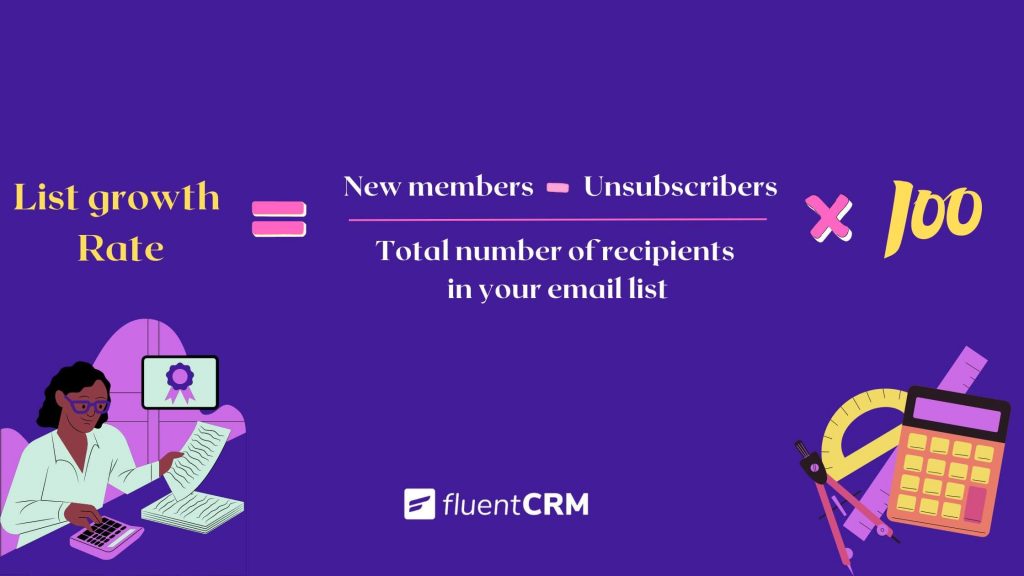
- Importance of list growth rate: List growth rate is important because it assists you in developing a high-converting email list and helps you understand whether your lead generation method is effective or not.
Email sharing rate
Although email sharing and forwarding rates are not prioritized, they are still very important metrics. It demonstrates how effective your email content is at enticing your recipients to share it on various social media platforms.
In essence, it’s the proportion of email recipients who chose to forward emails to friends or click the “share this” button to post email content to a social network.
- How to calculate social share rate: To calculate the social share rate divide the total number of shared emails by the total number of emails delivered and multiply the figure by hundred.
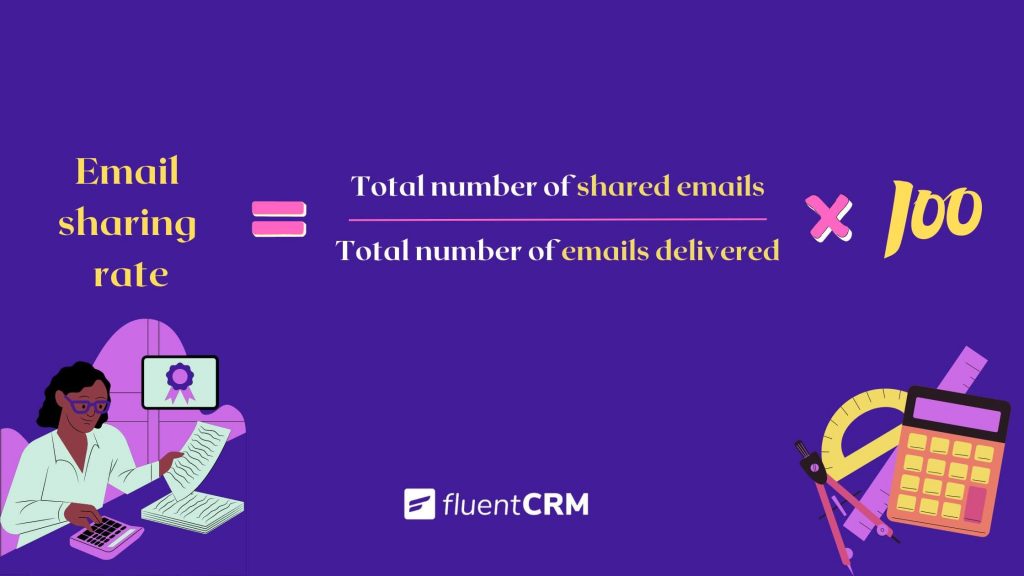
- The importance of social share rate: Social share rate is important because it assists you in discovering new channels for generating leads and allows you to forecast the number of new leads you will receive through various channels
Spam complaints
Unsubscription isn’t the worst fate that your emails can face; there is another: spam complaints. It is your responsibility as an email marketer to monitor how well your emails comply with various cyber laws. If both the unsubscribe and spam rates are high, there may be a serious problem with your emails as well as your email-sending methods.
Which email marketing KPIs are the most effective?
All of the KPIs mentioned above are important and will greatly assist you. Keep in mind that, trusting only one metric will never be a wise move because no single email marketing KPI can ever accurately capture the overall picture of an email marketing campaign.
If email deliverability is your primary objective, metrics like open rate, click rate, and click-through rate are the most important metrics to monitor.
While metrics such as conversion rate and ROI will show how well your marketing strategy is performing, Bounce rate, spam complaints, and unsubscribe rate indicate flaws in your approach.
Finally, the email sharing rate and list growth rate will show whether your emails are exhilarating to your customers or not.
That is why, rather than focusing on a single metric, we recommend tracking three or four metrics at a time to determine the exact scenario. And which KPIs we should track should be determined by your goal and business type.
That’s all for today. Have a good day!



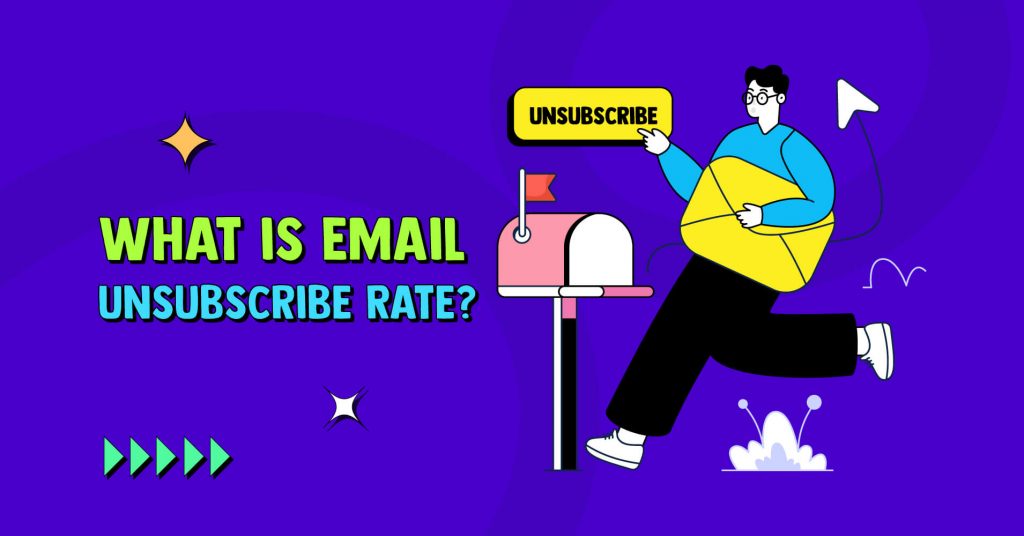





Leave a Reply